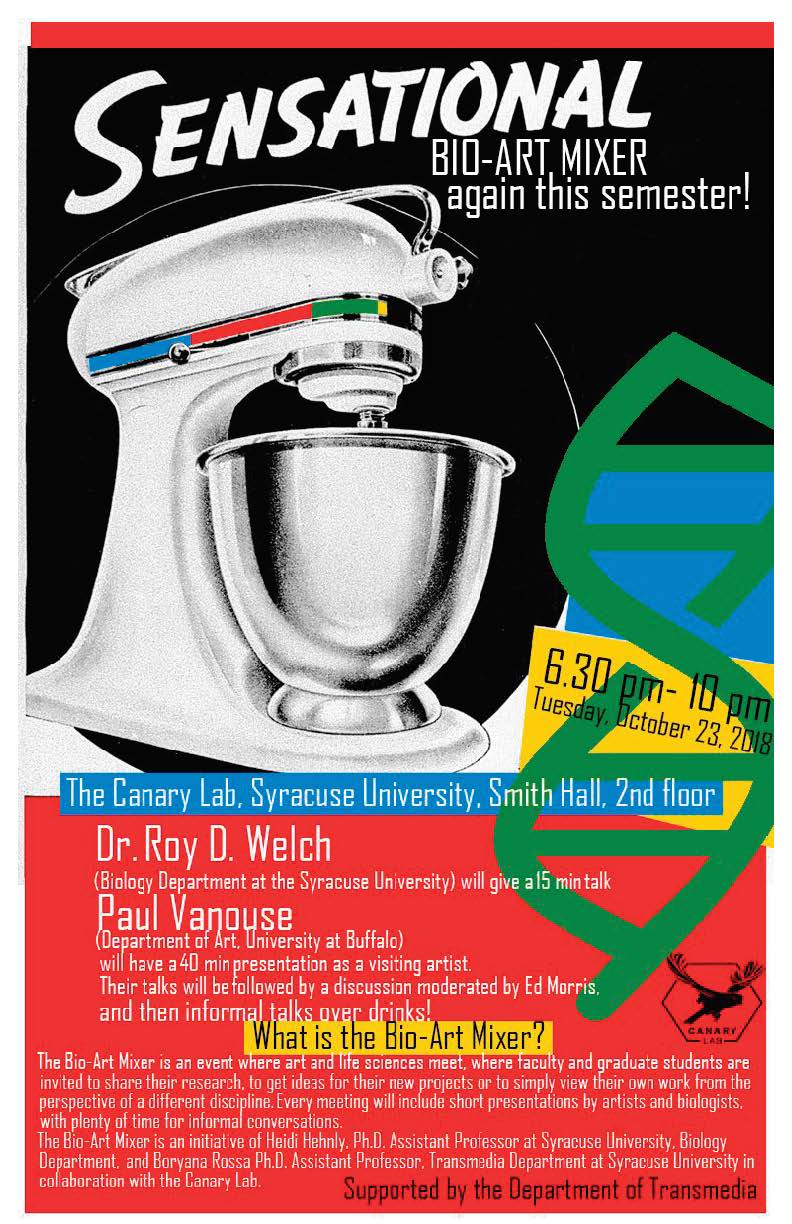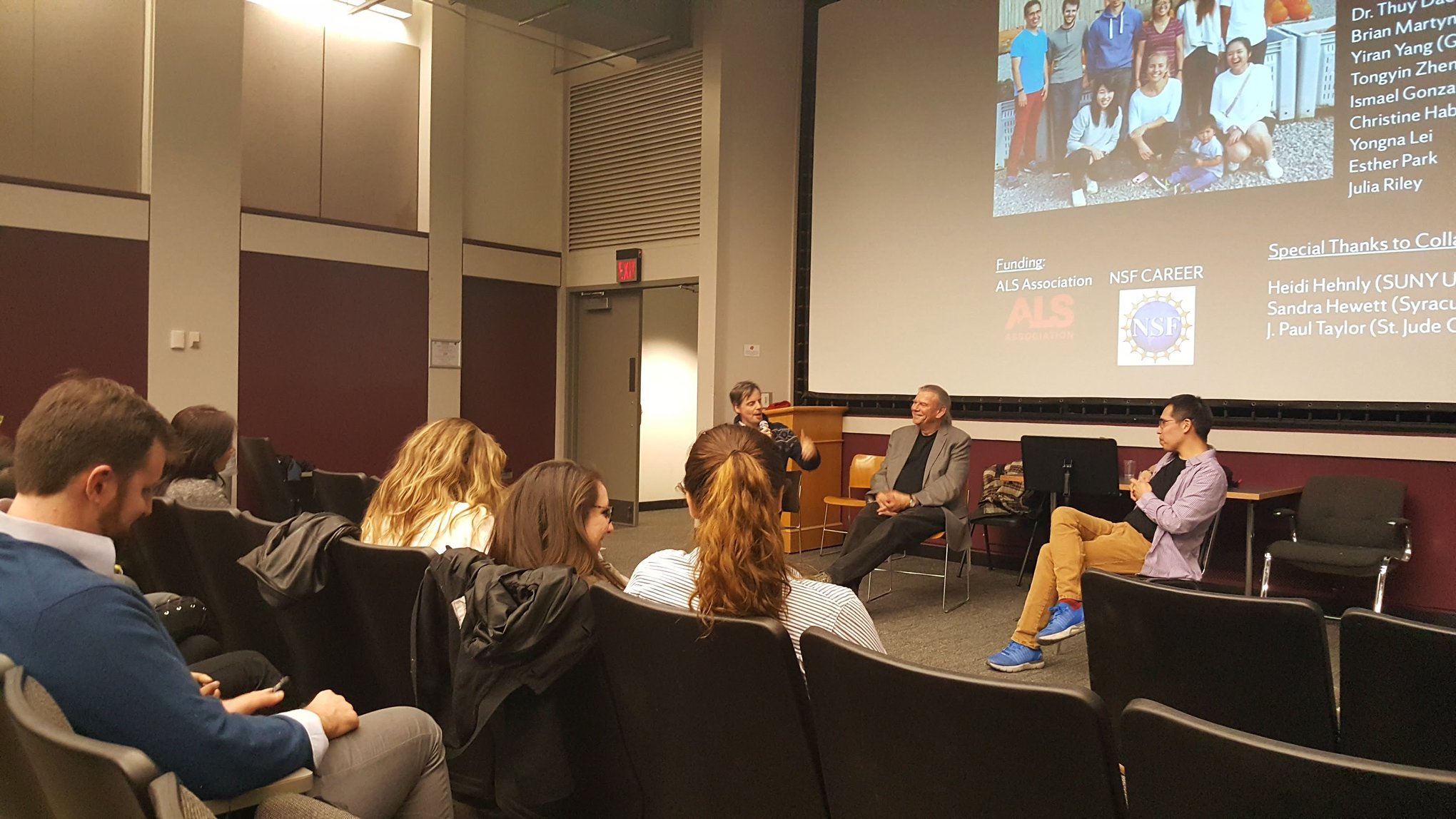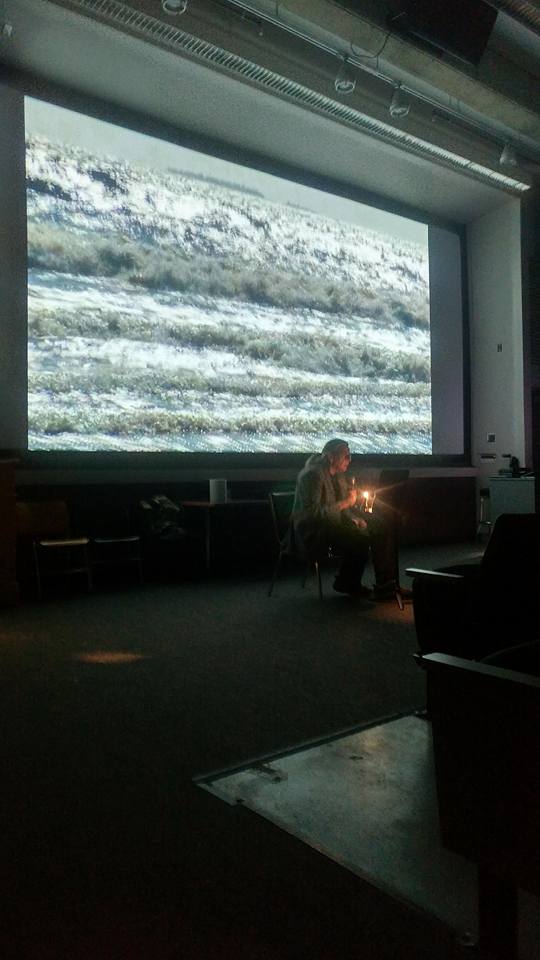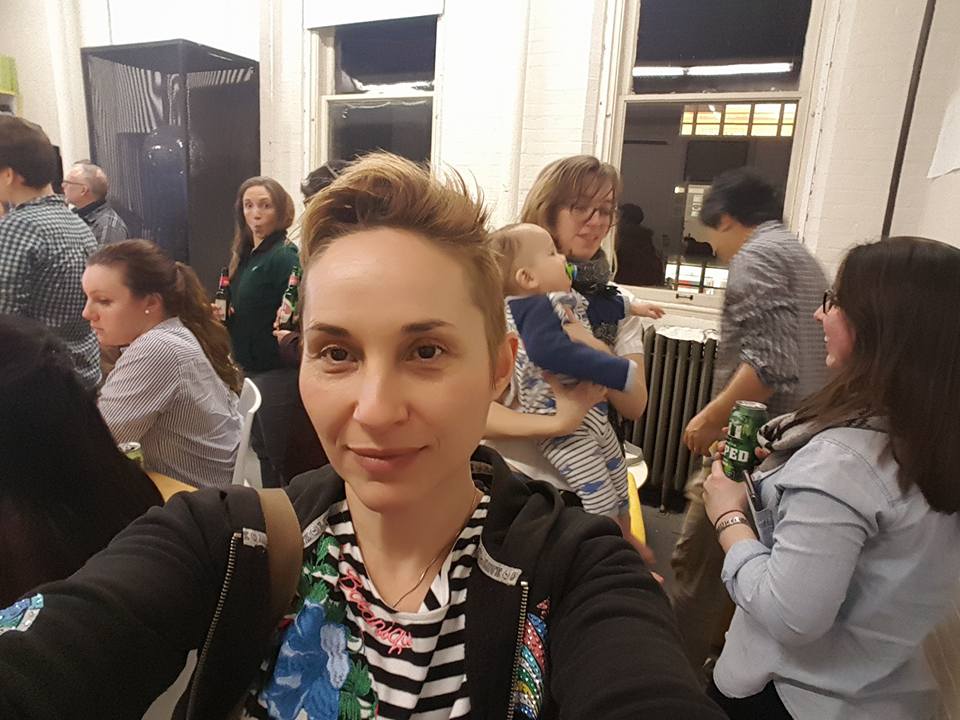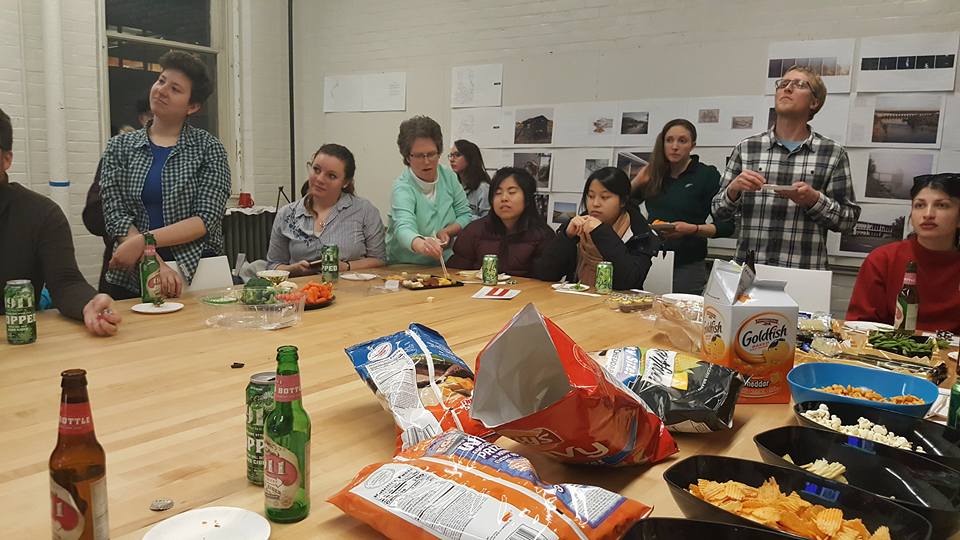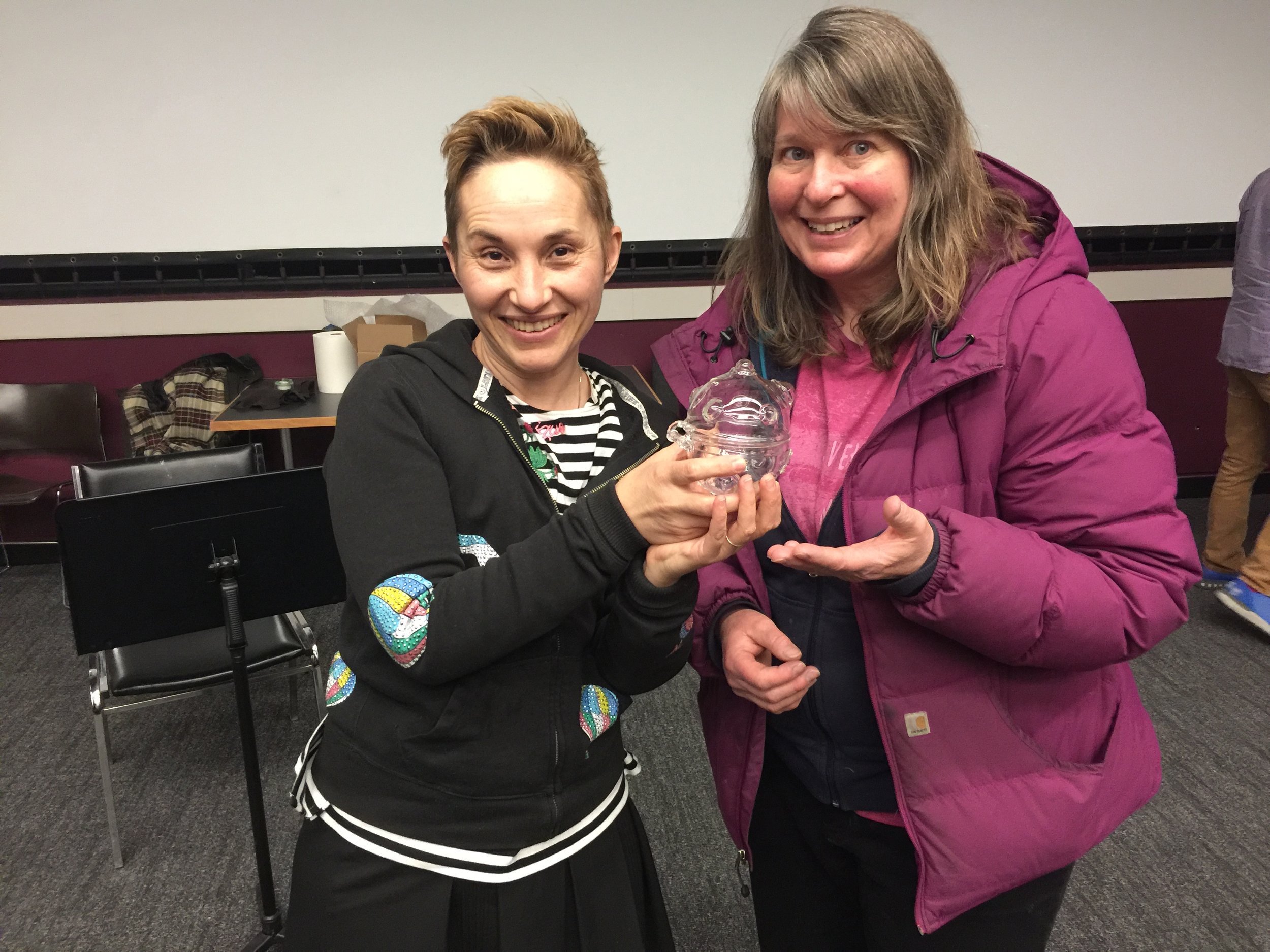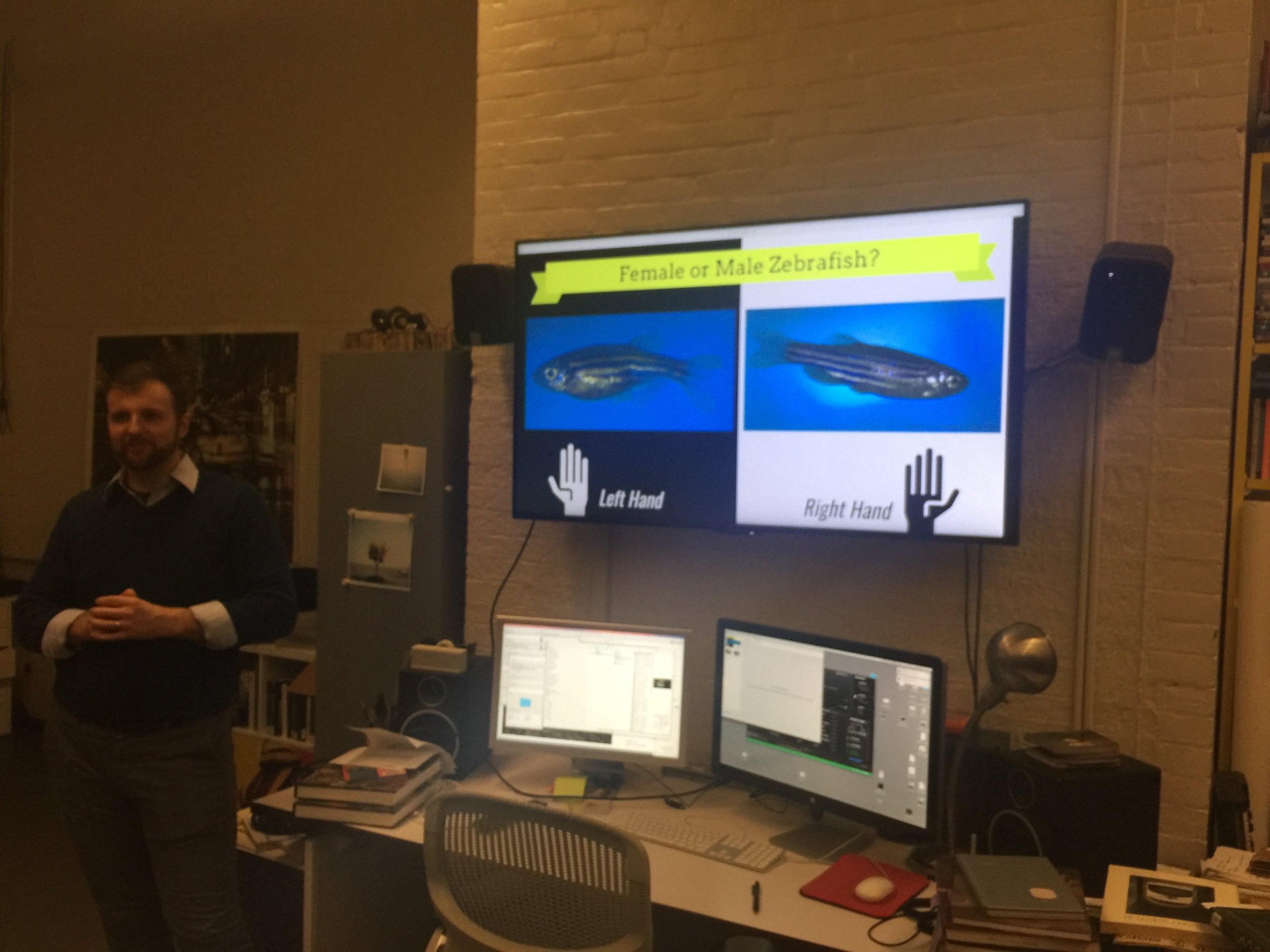Check out Erica’s recent publication in Cytoskeleton titled “Regulating a key mitotic regulator, polo-like kinase 1 (PLK1)”. You can find the article here. Here’s her beautiful cover below, which is a Structured Illumination Microscopy Micrograph of PLK1 (Fire Look-up Table) and kinetochores (CREST, white) during different stages of the cell cycle.
It's time for another Bio-art mixer! On October 23rd
Oct 23, Tuesday, 2018
6.30-10 pm
The Canary Lab, Smith Hall, 2nd floor, Syracuse University
https://www.facebook.com/events/175580630018821/
Please make sure to spread the word in your departments and advertise! It’s great fun for students, faculty, and friends!
6.30 pm - Talks
We have two speakers Dr. Roy D. Welch (Biology Department at the Syracuse University) and Paul Vanouse (Department of Art, University at Buffalo). Dr. Roy D. Welch will give a 15 min talk and Paul Vanouse will have a 40min presentation as a visiting artist.
8.30pm- Confab
Guests’ talks will be followed by a discussion moderated by Ed Morris and by informal talks over drinks at The Canary Lab!
Paul Vanouse (Professor of Art, Director of Coalesce Center for Biological Art, Co-Director of Emerging Practices MFA, University at Buffalo)
http://www.paulvanouse.com
Paul Vanouse is an artist working in Emerging Media forms. Radical interdisciplinarity and impassioned amateurism guide his practice.
Since the early 1990s his artwork has addressed complex issues raised by varied new techno-sciences using these very techno-sciences as a medium. His artworks have included data collection devices that examine the ramifications of polling and categorization, genetic experiments that undermine scientific constructions of race and identity, and temporary organizations that playfully critique institutionalization and corporatization. These "Operational Fictions" are hybrid entities--simultaneously real things and fanciful representations--intended to resonate in the equally hyper-real context of the contemporary electronic landscape.
Roy D. Welch (Professor, Department of Biology, Syracuse University)
http://thecollege.syr.edu/people/faculty/pages/bio/Welch-Roy.html
Dr. Roy Welch studies the genetics of self-organizing behavior in the prokaryote Myxococcus xanthus through the application of molecular biology, modeling, and whole-genome analysis. Recently Dr. Welch’s lab has constructed over 100 microscopes by 3D printing to reveal how each gene in the Myxococcus xanthus genome impacts the structure and function of this communal organism to create multi-cellular structures. Dr. Welch's unique strategy in microscopic analysis of Myxococcus xanthus has been able to assign quantitative phenotype profiles to elucidate subtle functional changes linked to each gene.
What is the Bio-Art Mixer?
The Bio-Art Mixer is an event where art and life sciences meet, where faculty and graduate students are invited to share their research, to get ideas for their new projects or to simply view their own work from the perspective of a different discipline. Every meeting will include short presentations by artists and biologists, with plenty of time for informal conversations. The mixer will take place twice a semester. Our ambition is to make the Bio-Art Mixer a foundation for future exhibitions, demonstrations and new collaborative projects involving art and the life sciences, and to inspire interdisciplinary research across the universities in the region and to engage local communities.
The Bio-Art Mixer is an initiative of Heidi Hehnly, Ph.D. Assistant Professor at Syracuse University, Biology Department, and Boryana Rossa Ph.D. Assistant Professor, Transmedia Department at Syracuse University in collaboration with the Canary Lab.
A successful 2nd Bio-Art Mixer!
Thanks so much to Tom Sherman (Syracuse University) and Carlos Castaneda (Syracuse University) for their great talks and discussion during the Bio-Art Mixer on April 4th. I can't wait till next semester! Stay tuned.
Next Bio-Art on April 4 at 6:30!
Wednesday, April 4th, 2018, 6.30 pm.
6.30 pm- talks will be held at Shemin Auditorium at Shaffer Art Building, Syracuse University, ground floor
8.30pm- Confab will occur at the Canary Lab, Syracuse University
Smith Hall, 2nd floor where libations will be served.
This time we will have two speakers, followed by a discussion moderated by Ed Morris and a GAME designed by Mohini Dutta and Ben Norskov together with our informal talks over drinks!
Tom Sherman (Department of Transmedia, VPA, Syracuse University)
The Light Off the Water: If we stare into light reflecting off the surface of a body of water, does the apparatus of sight measure the light as an internal rhythm of after-vision? As the water-articulated light hits the retinas and is delivered to the brain through the optic nerves, is the resulting bioelectrical disturbance read in part as a form of silent ‘music’ in the brain? Do we lock into a parallel, slightly delayed, internal non-auditory beat structure as light is processed in the dark gap between external and internal images? Do we sense the bioelectrical undercurrent as the optic nerves fire?
Carlos Castaneda (Departments of Biology and Chemistry, Syracuse University)
Phasing in and out: Droplets and Disease: The very crowded environment of a human cell is full of biological material including protein, DNA and RNA. How do our cells organize this chaos? You may have learned of membrane-bound organelles like the nucleus and mitochondria in high school biology, but did you know that there are membraneLESS organelles too? We’ll talk about how these dynamic, membraneless entities act like liquid droplets inside cells, as well as how they assemble and disassemble. We are using microscopy and other methods to study how these membraneless bodies are disrupted in disease, especially neurological disorders such as ALS.
What is the Bio-Art Mixer?
The Bio-Art Mixer is an event where art and life sciences meet, where faculty and graduate students are invited to share their research, to get ideas for their new projects or to simply view their own work from the perspective of a different discipline. Every meeting we will have four short presentations and plenty of time for informal conversations. The mixer will take place twice a semester.
Our ambition is to make the Bio-Art Mixer a foundation for future exhibitions, demonstrations and new collaborative projects involving art and the life sciences, and to inspire interdisciplinary research across the universities in the region and to engage local communities.
The Bio-Art Mixer is an initiative of Heidi Hehnly, Ph.D. Assistant Professor at SUNY Upstate Medical University and Boryana Rossa Ph.D. Assistant Professor, Transmedia Department at Syracuse University in collaboration with the Canary Lab.

